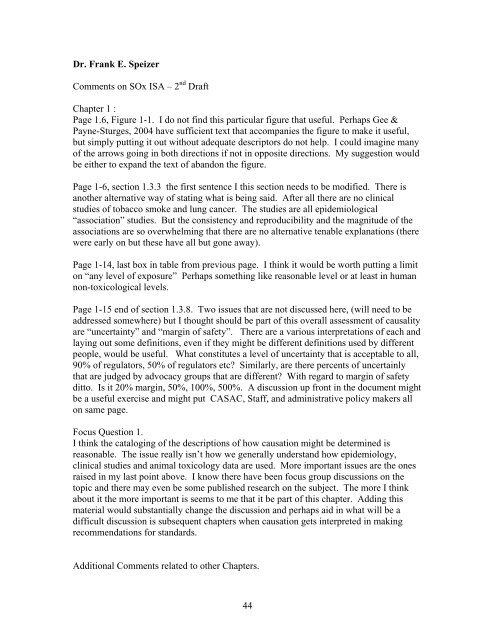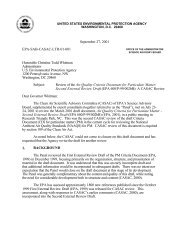(CASAC) Peer Review of EPA's Integrated Science Assessment
(CASAC) Peer Review of EPA's Integrated Science Assessment
(CASAC) Peer Review of EPA's Integrated Science Assessment
You also want an ePaper? Increase the reach of your titles
YUMPU automatically turns print PDFs into web optimized ePapers that Google loves.
Dr. Frank E. SpeizerComments on SOx ISA – 2 nd DraftChapter 1 :Page 1.6, Figure 1-1. I do not find this particular figure that useful. Perhaps Gee &Payne-Sturges, 2004 have sufficient text that accompanies the figure to make it useful,but simply putting it out without adequate descriptors do not help. I could imagine many<strong>of</strong> the arrows going in both directions if not in opposite directions. My suggestion wouldbe either to expand the text <strong>of</strong> abandon the figure.Page 1-6, section 1.3.3 the first sentence I this section needs to be modified. There isanother alternative way <strong>of</strong> stating what is being said. After all there are no clinicalstudies <strong>of</strong> tobacco smoke and lung cancer. The studies are all epidemiological“association” studies. But the consistency and reproducibility and the magnitude <strong>of</strong> theassociations are so overwhelming that there are no alternative tenable explanations (therewere early on but these have all but gone away).Page 1-14, last box in table from previous page. I think it would be worth putting a limiton “any level <strong>of</strong> exposure” Perhaps something like reasonable level or at least in humannon-toxicological levels.Page 1-15 end <strong>of</strong> section 1.3.8. Two issues that are not discussed here, (will need to beaddressed somewhere) but I thought should be part <strong>of</strong> this overall assessment <strong>of</strong> causalityare “uncertainty” and “margin <strong>of</strong> safety”. There are a various interpretations <strong>of</strong> each andlaying out some definitions, even if they might be different definitions used by differentpeople, would be useful. What constitutes a level <strong>of</strong> uncertainty that is acceptable to all,90% <strong>of</strong> regulators, 50% <strong>of</strong> regulators etc? Similarly, are there percents <strong>of</strong> uncertainlythat are judged by advocacy groups that are different? With regard to margin <strong>of</strong> safetyditto. Is it 20% margin, 50%, 100%, 500%. A discussion up front in the document mightbe a useful exercise and might put <strong>CASAC</strong>, Staff, and administrative policy makers allon same page.Focus Question 1.I think the cataloging <strong>of</strong> the descriptions <strong>of</strong> how causation might be determined isreasonable. The issue really isn’t how we generally understand how epidemiology,clinical studies and animal toxicology data are used. More important issues are the onesraised in my last point above. I know there have been focus group discussions on thetopic and there may even be some published research on the subject. The more I thinkabout it the more important is seems to me that it be part <strong>of</strong> this chapter. Adding thismaterial would substantially change the discussion and perhaps aid in what will be adifficult discussion is subsequent chapters when causation gets interpreted in makingrecommendations for standards.Additional Comments related to other Chapters.44
















